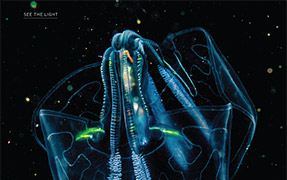Ring defect enhances the performance of photonic crystal surface-emitting lasers
Single-mode vertical-cavity surface-emitting lasers (VCSELs) with high spectral purity and low output power are in great demand for applications related to sensing, atomic clocks, and spectroscopy. Pumping and communications, on the other hand, require high output power. Single-mode output power from conventional oxide-confined VCSELs is limited to about 3mW.1 It may be boosted by enlarging the oxide aperture, but the spectral purity deteriorates. In the past few years, photonic crystal has been used to improve the performance of VCSELs. Single-point-defect devices with small circular beams were the first to be developed.2, 3 Later, two- or four-point-defect photonic crystal VCSELs based on coherent coupling technology and multiple beams enabled single-mode operation with high spectral purity.4


The output power of these devices is still limited, however. Here, we report a ring-defect photonic crystal VCSEL (see Figure 1).5 Formed by removing the six airholes nearest to a central airhole in a triangular lattice, the defect serves as an optical aperture for emitted light. This structure has two advantages. First, removing the airholes enlarges the optical aperture. Second, the ring defect's approximately radial symmetry can be simplified to a 1D VCSEL array along any direction in a plane. Based on this simplification, we used coupled-mode theory to predict the possible excited modes of the device (the fewer the modes, the better) and, consequently, their far-field profiles.6, 7 Our calculations indicated both an out-of-phase mode (180° phase difference between the two elements) and an in-phase mode (0° phase difference). The former should be easier to excite at longer wavelengths and more stable owing to reduced loss.
Experiments showed that, because of its enlarged optical aperture, the ring-defect VCSEL has larger output power compared with point-defect devices (see Figure 2). At lower current, the laser exhibits only one mode, but as current increases, a mode also begins to appear at the shorter wavelength (see Figure 3). To identify these two modes, we compared the measured far-field patterns with our calculated results (see Figure 4) and the spectra. We found that the out-of-phase mode with the longer wavelength is indeed excited first at the low current range and that the in-phase mode is excited at the shorter wavelength given sufficient current. The observed spectral separation of the two modes is about 0.1nm. The far field combines the two modes to achieve a circular beam.
Photonic crystal technology makes it easy to form various types of optical apertures. Consequently, we can integrate the ring and point defects to further enlarge the optical aperture.8 Simplifying this structure to a 1D VCSEL array, composed of three elements, yields at most three possible excited modes. The structure offers high output power and spectral purity because of the field interaction between the two defects.
In summary, we have created VCSELs using ring defects as optical apertures based on photonic crystal technology. These devices both improve output power and achieve a circular beam, which makes VCSELs more suitable for applications such as pumping and communications. But there is always more than one excited mode in the devices, which limits the spectral purity and the far field. To realize single-, in-phase-mode operation, we plan to carefully optimize the photonic crystal structure to create a substantially smaller circular beam with easy focusing and high coupling efficiency to the fiber.





